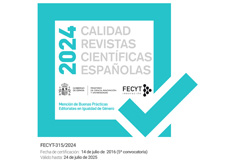Un sendero de tópicos y falacias: Esparta en la ficción y en la historia popular
DOI:
https://doi.org/10.12795/spal.2011.i20.03Palabras clave:
Esparta, espejismo, mito, modelo, estereotipo, distorsión, imagen, cine, televisión, novela histórica.Resumen
Nos ocupamos en este artículo de la imagen de Esparta y de los espartanos en la ficción y la historia popular, esto es, en el cine, la televisión, el cómic y la novela histórica. Comprobaremos que, como a lo largo de todo el pensamiento occidental, se trata de una idea estereotipada, distorsionada y teñida por el mito, producto de un uso acrítico de las fuentes antiguas, pero muy del gusto de las masas. Consecuentemente, estos medios retroalimentan y perpetúan tal mirage pese a que la historiografía moderna la ha demolido, o por lo menos matizado, en las últimas décadas.
Descargas
Citas
ALVAR, J. (2007): «Jerjes, ¿una drag queen?», Clío. Revista de Historia 69: 14-18.
BRIDGES, E. 2007: «The Guts and the Glory. Pressfield´s Spartans at the Gates of Fire», en E. Bridges, E. Hall, y P.J. Rhodes (edd.), Cultural Responses to the Persian Wars. Antiquity to the Third Millennium: 404-421. Oxford.
CARTLEDGE, P. (2001): Spartan Reflections. London.
CARTLEDGE, P. (2003): «Raising Hell? The Helot Mirage: A Personal Re-View», en N. Luraghi y S. Alcock (edd.), Helots and their Masters in Laconia and Messenia: Histories, Ideologies, Structures: 12-30. Washington D.C.
CARTLEDGE, P. (2006): «Spartan traditions and receptions», Hermathena 181: 41-49.
CARTLEDGE, P. (2007): Termópilas. La batalla que cambió el mundo, Barcelona (original inglés de 2006).
CARTLEDGE, P. (2009): Los espartanos. Una historia épica. Barcelona (original inglés de 2002).
CEPEDA RUIZ, J.D. (2006): «La ciudad sin muros: Esparta durante los períodos arcaico y clásico», Antigüedad y Cristianismo 23: 939-951.
FANDIÑO PÉREZ, R.G. (2008): «Una vez más fascinante fascismo. Comentarios sobre 300 de Zack Zinder (2007)», Historia Actual Online 15: 145-156.
FORNIS, C. (2003): Esparta. Historia, sociedad y cultura de un mito historiográfico. Barcelona.
FORNIS, C. (2008): Grecia exhausta. Ensayo sobre la guerra de Corinto. Hypomnemata 175. Göttingen.
FOTHERINGHAM, L.S. (2012): «The Positive Portrayal of Sparta in Late Twentieth-Century Fiction», en S. Hodkinson e I. MacGregor Morris (edd.), Sparta in Modern Thought: 393-428. Swansea.
LAPEÑA MARCHENA, O. 2011: «Algunas reflexiones acerca del tratamiento cinematográfico de las guerras médicas», en Grecia ante los imperios, Anejos de Spal XV: 427-438. Sevilla.
LEVENE, D.S. (2007): «Xerxes Goes to Hollywood», en E. Bridges, E. Hall y P.J. Rhodes (edd.), Cultural Responses to the Persian Wars. Antiquity to the Third Millennium: 383-403. Oxford.
LÉVY, E. (2003): Sparte. Histoire politique et sociale jusqu´à la conquête romaine. Paris.
LILLO REDONET, F. (2008): «Sparta and Ancient Greece in The 300 Spartans», en I. Berti y M. García Morcillo (edd.), Hellas on Screen. Cinematic Receptions of Ancient History, Literature and Myth: 117-130. Stuttgart.
LILLO REDONET, F. (2010): Héroes de Grecia y Roma en la pantalla. Madrid.
MACGREGOR MORRIS, I. (2004): Leonidas. Hero of Thermopylae. New York.
MATALAS, P. (2007): «Sparta in the Contemporary World of Images» [en griego, con resumen en inglés], en N. Birgalias, K. Buraselis y P. Cartledge (edd.), The Contribution of Ancient Sparta to Political Thought and Practice: 463-481. Athens.
NISBET, G. (2008): Ancient Greece in Film and Popular Culture. Exeter2.
NISBET, G. (2012): «“This is Cake-Town!”: 300 (2006) and the death of allegory», en S. Hodkinson y I. MacGregor Morris (edd.), Sparta in Modern Thought: 429-458. Swansea.
OLLIER, F. (1933-1943): Le mirage spartiate. Étude sur l’idéalisation de Sparte dans l’antiquité grecque, I-II. Paris.
PRIETO, A. (2009): «Esparta reinventada: el cine», en J.M. Caparrós (coord.), Historia & Cinema: 171-186. Barcelona.
TIGERSTEDT, E.N. (1965-1978): The Legend of Sparta in Classical Antiquity, 3 vols. Stockholm.
Publicado
Cómo citar
Número
Sección
Licencia

Esta obra está bajo una licencia internacional Creative Commons Atribución-NoComercial-SinDerivadas 4.0.









